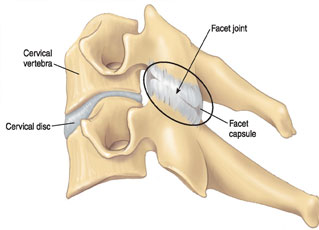Physio Health Advice > Wry Neck (Acute Torticollis)
What is it?
Wry Neck refers to a condition where one side of the neck suddenly becomes extremely painful and the patient is unable to turn their head in the direction of pain. It is typical to wake up with the pain and clinically it is classified as either Facet Joint Wry Neck or Discogenic Wry Neck.
What causes it?
Facet Joint Wry Neck:
Facet joints are found on each side of the neck between two vertebrae and allow controlled rotation and side bending of the neck. Sometimes something simple such as sleeping in an awkward position or a quick, jerky movement of the neck, can cause the tissues of this joint to tear or become stuck. In addition, the muscles surrounding the area begin to spasm, increasing the pain and restriction of the neck. The pain is usually sharp and doesn’t travel further than the shoulder blade.
Discogenic Wry Neck:
The spinal disc is a stress absorbing structure, which sits between the vertebrae of the neck. The disc can sometimes bulge under stress or tear, like a small sprain and the resulting swelling puts pressure on the nearby nerves. Movement is not actually blocked, but because there are so many nerve endings around the spine, a small amount of damage can feel extremely painful.
This type of wry neck is usually caused by a combination of factors such as neck stiffness, poor posture and biomechanics. It can also take a much longer time to heal. The pain is often described as a dull ache, can radiate into the arm and can be associated with pins and needles.
Both conditions can be seen at any age, but facet joint wry neck is more often seen in teenagers. Note: If these symptoms are seen in young children it can be a sign of a much more serious condition. It is important to seek immediate medical attention, particularly if symptoms are accompanied by fever.
How is it treated?
Immediate treatment for both conditions will be to reduce pain and muscle spasm with techniques such as massage, heat, taping, shoulder blade repositioning, TENS and ultrasound. For facet joint wry neck your physiotherapist may be able to unlock the ‘caught’ joint with gentle mobilizations and get you on the road to recovery. With treatment you should be moving freely within a few days and fully recovered within a week.
 Discogenic wry neck is more complicated to treat and rehabilitation will be aimed at reducing pressure in the disc, reduction of muscle spasm, mobilization of any stiff joints, correction of any muscle imbalance and postural re-education. While the initial pain should subside quite quickly, it might take up to six weeks to feel fully recovered from discogenic wry neck.
Discogenic wry neck is more complicated to treat and rehabilitation will be aimed at reducing pressure in the disc, reduction of muscle spasm, mobilization of any stiff joints, correction of any muscle imbalance and postural re-education. While the initial pain should subside quite quickly, it might take up to six weeks to feel fully recovered from discogenic wry neck.
It’s important to seek treatment as early as possible to ensure a fast and smooth recovery. However, before your appointment you can carefully apply a heat pack to the painful side. Your physiotherapist can confirm the diagnosis and prescribe a treatment program to ensure you keep active and pain free in the future.


